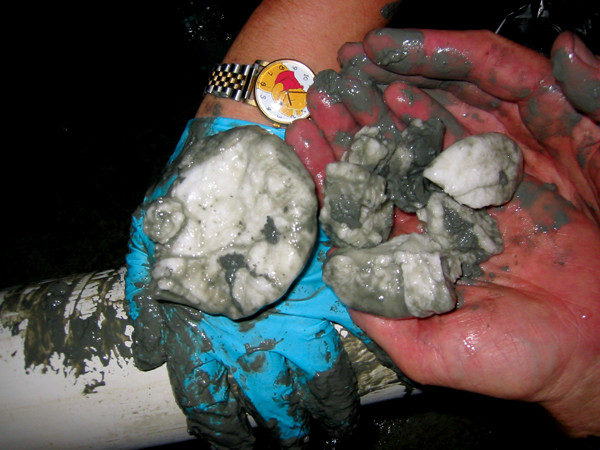
by Sara E. Pratt Thursday, February 23, 2012

Methane hydrate recovered during a U.S. Geological Survey gas hydrate research cruise in the Gulf of Mexico in 2002. Passive acoustic techniques may be used to find gas hydrate deposits. William Winters, USGS
In recent decades, active acoustic surveys have been used to detect methane seeps and gas hydrates — deposits of crystalline solids consisting of gas molecules, usually methane, surrounded by a cage of water molecules — buried under the seafloor.
Methane is a potent greenhouse gas with 20 times the heat-trapping capacity of carbon dioxide, so it is important to know how much is seeping out of the ocean and into the atmosphere. But it could also be a valuable fuel source; some studies estimate that the amount of energy in hydrates is equivalent to twice that of all other fossil fuels. “Probably the most important motivation for detecting the gas hydrates is its potential as a future energy resource,” says Olivier Carrière, a physicist in the Marine Physical Laboratory at Scripps Institution of Oceanography in La Jolla, Calif.
At the annual meeting of the American Geophysical Union in San Francisco, Calif., last December, Carrière and colleagues reported a new technique to detect gas hydrate deposits. The new technique relies on ambient noise in the sea — from waves as well as commercial, military and merchant ships — to passively detect gas hydrate deposits in the seabed.
Because sound travels more than four times as fast in water as it does in air, it has long been employed as a means of exploring and observing the ocean depths. Active acoustic surveys have been used for decades for everything from detecting naval submarine movement to monitoring whale migration to finding oil and gas. However, active acoustic surveys, like sonar or seismic, require a sound-generating device, like an air or water gun to “ping” the bottom, and detectors, either onboard or towed behind a ship, that detect the reflected echo. Thus, active acoustics involving equipment and ship time can be costly.
Now, some researchers, like Carrière, are developing inexpensive passive acoustic techniques that can be deployed on the seafloor to patiently listen for gas leaks and seeps and even identify pockets of gas under the seafloor.
© 2008-2021. All rights reserved. Any copying, redistribution or retransmission of any of the contents of this service without the expressed written permission of the American Geosciences Institute is expressly prohibited. Click here for all copyright requests.